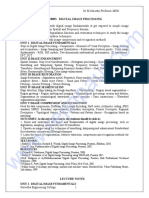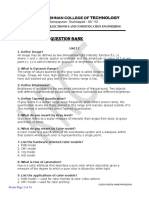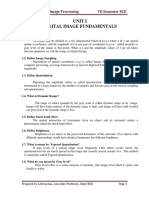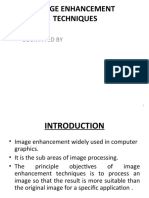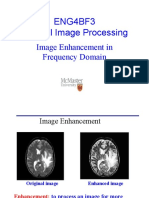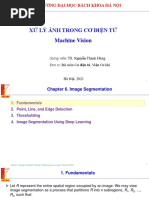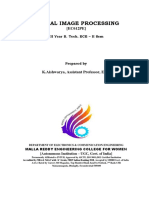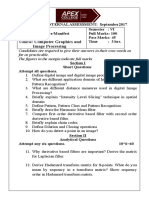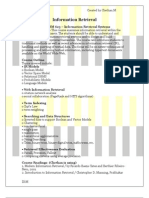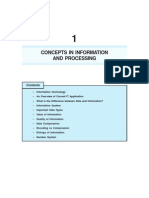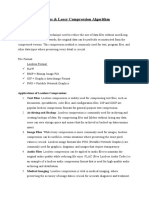Image Processing QB
Uploaded by
subramanyam62Image Processing QB
Uploaded by
subramanyam62Dr.N.G.P.
Institute of Technology /Department of Electronics and Communication Engineering
IT6005 DIGITAL IMAGE PROCESSING L TPC
3 00 3
UNIT I DIGITAL IMAGE FUNDAMENTALS 8
Introduction – Origin – Steps in Digital Image Processing – Components – Elements of Visual
Perception – Image Sensing and Acquisition – Image Sampling and Quantization – Relationships
between pixels – color models.
UNIT II IMAGE ENHANCEMENT 10
Spatial Domain: Gray level transformations – Histogram processing – Basics of Spatial Filtering–
Smoothing and Sharpening Spatial Filtering – Frequency Domain: Introduction to Fourier
Transform – Smoothing and Sharpening frequency domain filters – Ideal, Butterworth and
Gaussian filters.
UNIT III IMAGE RESTORATION AND SEGMENTATION 9
Noise models – Mean Filters – Order Statistics – Adaptive filters – Band reject Filters – Band
pass Filters – Notch Filters – Optimum Notch Filtering – Inverse Filtering – Wiener filtering
Segmentation: Detection of Discontinuities–Edge Linking and Boundary detection – Region
based segmentation- Morphological processing- erosion and dilation.
UNIT IV WAVELETS AND IMAGE COMPRESSION 9
Wavelets – Subband coding – Multiresolution expansions Compression: Fundamentals – Image
Compression models – Error Free Compression – Variable Length Coding – Bit-Plane Coding –
Lossless Predictive Coding – Lossy Compression – Lossy Predictive Coding – Compression
Standards.
UNIT V IMAGE REPRESENTATION AND RECOGNITION 9
Boundary representation – Chain Code – Polygonal approximation, signature, boundary segments
– Boundary description – Shape number – Fourier Descriptor, moments- Regional Descriptors –
Topological feature, Texture – Patterns and Pattern classes – Recognition based on matching.
TOTAL: 45 PERIODS
TEXT BOOK:
1. Rafael C. Gonzales, Richard E. Woods, “Digital Image Processing”, Third Edition, Pearson
Education, 2010.
REFERENCES:
1. Rafael C. Gonzalez, Richard E. Woods, Steven L. Eddins, “Digital Image Processing Using
MATLAB”, Third Edition Tata McGraw Hill Pvt. Ltd., 2011.
Question Bank- Two Marks With Answer IT6005/Digital Image Processing
Dr.N.G.P. Institute of Technology /Department of Electronics and Communication Engineering
2. Anil Jain K. “Fundamentals of Digital Image Processing”, PHI Learning Pvt. Ltd., 2011.
3. Willliam K Pratt, “Digital Image Processing”, John Willey, 2002.
4. Malay K. Pakhira, “Digital Image Processing and Pattern Recognition”, First Edition, PHI
Learning Pvt. Ltd., 2011.
5. http://eeweb.poly.edu/~onur/lectures/lectures.html.
6. http://www.caen.uiowa.edu/~dip/LECTURE/lecture.html
Question Bank- Two Marks With Answer IT6005/Digital Image Processing
Dr.N.G.P. Institute of Technology /Department of Electronics and Communication Engineering
UNIT I: DIGITAL IMAGE FUNDAMENTALS
1. Define Image?
An image may be defined as two dimensional light intensity function f(x, y) where x and y denote
spatial co-ordinate and the amplitude or value of f at any point (x, y) is called intensity or grayscale or
brightness of the image at that point.
2. What is Dynamic Range?
The range of values spanned by the gray scale is called dynamic range of an image. Image will
have high contrast, if the dynamic range is high and image will have dull washed out gray look if the
dynamic range is low.
3. Define Brightness? AU NOV/DEC 2012
Brightness of an object is the perceived luminance of the surround. Two objects with different
surroundings would have identical luminance but different brightness.
4. Define Tapered Quantization
If gray levels in a certain range occur frequently while others occurs rarely, the quantization
levels are finely spaced in this range and coarsely spaced outside of it. This method is sometimes called
Tapered Quantization.
5. What do you meant by Gray level?
Gray level refers to a scalar measure of intensity that ranges from black to grays and finally to
white.
6. What do you meant by Color model?
A Color model is a specification of 3D-coordinates system and a subspace within that system
where each color is represented by a single point.
7. List the hardware oriented color models?
1. RGB model
2. CMY model
3. YIQ model
4. HSI model
8. Define Hue and saturation? AU May /June 2013,Nov/Dec 2016
Hue is a color attribute that describes a pure color where saturation gives a measure of the degree
to which a pure color is diluted by white light.
9. List the applications of color models?
1. RGB model--- used for color monitor & color video camera
2. CMY model---used for color printing
3. HIS model----used for color image processing
4. YIQ model---used for color picture transmission
Question Bank- Two Marks With Answer IT6005/Digital Image Processing
Dr.N.G.P. Institute of Technology /Department of Electronics and Communication Engineering
10. What is Chromatic Adoption?
The hue of a perceived color depends on the adoption of the viewer. For example, the American
Flag will not immediately appear red, white, and blue of the viewer has been subjected to high intensity
red light before viewing the flag. The color of the flag will appear to shift in hue toward the red
component cyan.
11. Define Resolutions?
Resolution is defined as the smallest number of discernible detail in an image.Spatial resolution is
the smallest discernible detail in an image and gray level resolution refers to the smallest discernible
change is gray level.
12. What is meant by pixel? AU MAY/JUNE 2009
A digital image is composed of a finite number of elements each of which has a particular location
or value. These elements are referred to as pixels or image elements or picture elements or pels elements.
13. Define Digital image?
When x, y and the amplitude values of f all are finite discrete quantities , we call the image digital
image.
14. What are the steps involved in DIP?
1. Image Acquisition 2. Preprocessing 3. Segmentation 4. Representation and
Description 5. Recognition and Interpretation
15. What is recognition and Interpretation?
Recognition means is a process that assigns a label to an object based on the information provided
by its descriptors. Interpretation means assigning meaning to a recognized object.
16. Specify the elements of DIP system?
1. Image Acquisition 2. Storage 3. Processing 4. Display 5.Computer
17. Explain the categories of digital storage?
1. Short term storage for use during processing.
2. Online storage for relatively fast recall.
3. Archical storage for infrequent access.
18. What are the applications of digital image processing systems ? AU NOV/DEC 2007
1. Medical Image applications 2. Satellite Imagery 3. Remote sensing
4.Automotives 5. Communications
19. Distinguish between photopic and scotopic vision? (Nov/Dec 2017)
Photopic vision Scotopic vision
1. The human being can resolve the fine details with these cones because each one is connected to its
own nerve end.
2. This is also known as bright light vision. Several rods are connected to one nerve end. So it gives the
overall picture of the image. This is also known as thin light vision.
Question Bank- Two Marks With Answer IT6005/Digital Image Processing
Dr.N.G.P. Institute of Technology /Department of Electronics and Communication Engineering
20. How cones and rods are distributed in retina? AU APRIL/MAY 2011
In each eye, cones are in the range 6-7 million and rods are in the range 75-150 million
.
21. Define subjective brightness and brightness adaptation?
Subjective brightness means intensity as preserved by the human visual system. Brightness adaptation
means the human visual system can operate only from scotopic to glare limit. It cannot operate over the range
simultaneously. It accomplishes this large variation by changes in its overall intensity.
22. Define weber ratio AU MAY /JUNE 2009
The ratio of increment of illumination to background of illumination is called as weber ratio.(ie) Δi/i.If the
ratio (Δi/i) is small, then small percentage of change in intensity is needed (ie) good brightness adaptation. If the
ratio (Δi/i) is large , then large percentage of change in intensity is needed (ie) poor brightness adaptation.
23. What is meant by machband effect? Au April/May 2011,2013,2015 Nov/Dec 2016
Machband effect means the intensity of the stripes is constant. Therefore it preserves the brightness pattern
near the boundaries, these bands are called as machband effect.
24. What is simultaneous contrast?
The region reserved brightness not depend on its intensity but also on its background. All centre
square have same intensity. However they appear to the eye to become darker as the background becomes
lighter.
25. What is meant by illumination and reflectance?
Illumination is the amount of source light incident on the scene. It is represented as i(x, y).
Reflectance is the amount of light reflected by the object in the scene. It is represented by r(x, y).
26. Define sampling and quantization? AU APRIL/MAY 2007,2011,(Nov/Dec 2017)
Sampling means digitizing the co-ordinate value (x, y).Quantization means digitizing the
amplitude value.
27. Find the number of bits required to store a 256 X 256 image with 32 gray levels?
32 gray levels = 25 = 5 bits 256 * 256 * 5 = 327680 bits.
28. Write the expression to find the number of bits to store a digital image?
The number of bits required to store a digital image is b=M X N X k ,When M=N, this equation
becomes b=N^2k
30. What do you meant by Zooming of digital images?
Zooming may be viewed as over sampling. It involves the creation of new pixel locations and the
assignment of gray levels to those new locations.
31. What do you meant by shrinking of digital images?
Shrinking may be viewed as under sampling. To shrink an image by one half, we delete every
row and column. To reduce possible aliasing effect, it is a good idea to blue an image slightly before
shrinking it.
32. Write short notes on neighbors of a pixel. AU NOV/DEC 2009
The pixel p at co-ordinates (x, y) has 4 neighbors (ie) 2 horizontal and 2 vertical neighbors whose
Question Bank-
co-ordinates Two
is given Marksy),With
by (x+1, Answer
(x-1,y), IT6005/Digital
(x,y-1), (x, y+1). This is called Image
as direct neighbors. Processing
It is denoted
Dr.N.G.P. Institute of Technology /Department of Electronics and Communication Engineering
33. Explain the types of connectivity.
1. 4 connectivity
2. 8 connectivity
3. M connectivity (mixed connectivity)
34. What is meant by path?
Path from pixel p with co-ordinates (x, y) to pixel q with co-ordinates (s,t) is a sequence of
distinct pixels with co-ordinates.
35. Give the formula for calculating D4 and D8 distance.
D4 distance ( city block distance) is defined by D4(p, q) = |x-s| + |y-t| D8 distance(chess board distance) is
defined by D8(p, q) = max(|x-s|, |y-t|).
36. What is geometric transformation?
Transformation is used to alter the co-ordinate description of image.
The basic geometric transformations are
1. Image translation
2. Scaling
3. Image rotation
37. What is image translation and scaling?
Image translation means reposition the image from one co-ordinate location to another along
straight line path.
Scaling is used to alter the size of the object or image (ie) a co-ordinate system is scaled by a
factor.
38.Distinguish between Monochrome and gray scale image.(May/Jun 2016)
In a monochrome image,each pixel is stored as a single bit which is either 0 or 1.
In a gray scale image,each pixel is stored as a byte with a value between 0 and 255.
39.Compare RGB and HSI color image models.(Nov/Dec 2014)
RGB color image models
In the RGB color model, the three primary colors red, green and blue form the axis of the
cube. This is good for setting the electron gun of CRT.
It is device dependent and not perceptually uniform. This implies that the RGB model
will not in general reproduce the same colour from one display to another.
HSI model
H stands for Hue which is associated with the dominant colour as perceived by the
observer
S for saturation represents the purity of the colour
I for Intensity reflects the brightness
It is based on human colour perception
Question Bank- Two Marks With Answer IT6005/Digital Image Processing
Dr.N.G.P. Institute of Technology /Department of Electronics and Communication Engineering
40. When is fine sampling and coarse sampling used? (Apr/May 2017)
Fine sampling is required in the neighborhood of sharp gray level transitions while coarse sampling is
required in relatively smooth regions.
41.What is the function of image sensor? (Apr/May 2017)
Image sensor will produce an electrical output proportional to electric intensity falling on it.
Question Bank- Two Marks With Answer IT6005/Digital Image Processing
Dr.N.G.P. Institute of Technology /Department of Electronics and Communication Engineering
UNIT II- IMAGE ENHANCEMENT
1. Specify the objective of image enhancement technique.AU APR/MAY 2011
The objective of enhancement technique is to process an image so that the result is more suitable
than the original image for a particular application.
2. Explain the 2 categories of image enhancement. AU NOV/DEC 2012
i) Spatial domain refers to image plane itself & approaches in this category are based on direct
manipulation of picture image.
ii) Frequency domain methods based on modifying the image by fourier transform.
3. What is contrast stretching? AU MAY/JUNE 2009
Contrast stretching reduces an image of higher contrast than the original by darkening the levels
below m and brightening the levels above m in the image.
4. What is grey level slicing?
Highlighting a specific range of grey levels in an image often is desired. Applications include
enhancing features such as masses of water in satellite imagery and enhancing flaws in x-ray images.
5. Define image subtraction.
The difference between 2 images f(x,y) and h(x,y) expressed as, g(x,y)=f(x,y)-h(x,y) is obtained
by computing the difference between all pairs of corresponding pixels from f and h.
6. What is the purpose of image averaging? AU NOV/DEC 2007 , APR /MAY 2011
An important application of image averagingis in the field of astronomy, where imaging with
very low light levels is routine, causing sensor noise frequently to render single images virtually useless
for analysis.
7. What is meant by masking?
Mask is the small 2-D array in which the values of mask co-efficient determines the nature of
process.The enhancement technique based on this type of approach is referred to as mask processing.
8. Give the formula for negative and log transformation.
Negative: S=L-1-r
Log: s = c * log(1 + r) Where c-constant and r = input gray level value s=output gray level value
9. What is meant by bit plane slicing? AU NOV/DEC 2012
Instead of highlighting gray level ranges, highlighting the contribution made to total image
appearance by specific bits might be desired. Suppose that each pixel in an image is represented by 8 bits.
Imagine that the image is composed of eight 1-bit planes, ranging from bit plane 0 for LSB to bit plane-7
for MSB.
Question Bank- Two Marks With Answer IT6005/Digital Image Processing
Dr.N.G.P. Institute of Technology /Department of Electronics and Communication Engineering
10. Define histogram AU NOV/DEC 2009
The histogram of a digital image with gray levels in the range [0, L-1] shows us the distribution of
grey levels in the image.
11. What is meant by histogram equalization?
Spreading out the frequencies in an image (or equalising the image) is a simple way to improve dark
or washed out images
This transformation is called histogram equalization.
14. What is meant by laplacian filter?
The laplacian for a function f(x,y) of 2 variables is defined as,
2 f [ f ( x 1, y ) f ( x 1, y ) f ( x, y 1) f ( x, y 1)] 4 f ( x, y )
15. Write the steps involved in frequency domain filtering.
To filter an image in the frequency domain:
1. Compute F(u,v) the DFT of the image
2. Multiply F(u,v) by a filter function H(u,v)
3. Compute the inverse DFT of the result
Question Bank- Two Marks With Answer IT6005/Digital Image Processing
Dr.N.G.P. Institute of Technology /Department of Electronics and Communication Engineering
16. Give transfer function of a Butterworth low pass filter.
The transfer function of a Butterworth low pass filter of order n and with cut off frequency at a
distance D0 from the origin is, Where D(u , v) [(u M / 2) 2 (v N / 2) 2 ]1/ 2
1 if D (u , v ) D0
H (u , v )
0 if D (u, v ) D0
17. What do you mean by Point processing?
Image enhancement at any Point in an image depends only on the gray level at that point is often
referred to as Point processing. Point processing operations take the form s = T ( r ) where s refers to the
processed image pixel value and r refers to the original image pixel value
18. What is Image Negatives?
The negative of an image with gray levels in the range [0, L-1] is obtained by using the negative
transformation, which is given by the expression. s = L-1-r Where s is output pixel r is input pixel
19. Define Derivative filter?
For a function f (x, y), the gradient f at co-ordinate (x, y) is defined as the vector
f f
f ( x 1) f ( x) f ( y 1) f ( y )
x y
20. Explain spatial filtering?
Spatial filtering is the process of moving the filter mask from point to point in an image. For
linear spatial filter, the response is given by a sum of products of the filter coefficients, and the
corresponding image pixels in the area spanned by the filter mask.
Question Bank- Two Marks With Answer IT6005/Digital Image Processing
Dr.N.G.P. Institute of Technology /Department of Electronics and Communication Engineering
21. What is a Median filter?
The median filter replaces the value of a pixel by the median of the gray levels in the neighborhood
of that pixel.
22. What is maximum filter and minimum filter?
Minimum filter: Set the pixel value to the minimum in the neighbourhood of pixels. Minimum filter
used for finding darkest points in an image
Maximum filter: Set the pixel value to the maximum in the neighbourhood of pixels.Maximum filter
is used in finding brightest points in an image.
23. Write the application of sharpening filters?
1. Electronic printing and medical imaging to industrial application
2. Autonomous target detection in smart weapons.
24. Name the different types of derivative filters? AU NOV/DEC 2009 ,2008
1. Perwitt operators
2. Roberts cross gradient operators
3. Sobel operators
25. Give transfer function and frequency response of a Gaussian lowpass filter.
The transfer function of a Gaussian lowpass filter of order n and with cut off frequency at a
distance D0 from the origin is, Where D(u , v) [(u M / 2) 2 (v N / 2) 2 ]1/ 2
2
( u , v ) / 2 D0 2
H (u , v) e D
26. Give transfer function and frequency response of a high pass filter.
The transfer function of a high pass filter of order n and with cut off frequency at a
distance D0 from the origin is, Where D(u , v) [(u M / 2) 2 (v N / 2) 2 ]1/ 2
0 if D (u, v) D0
H (u , v)
1 if D (u , v) D0
Question Bank- Two Marks With Answer IT6005/Digital Image Processing
Dr.N.G.P. Institute of Technology /Department of Electronics and Communication Engineering
27. Give transfer function and frequency response of a Gaussian high pass filter.
The transfer function of a Gaussian lowpass filter of order n and with cut off frequency at a
distance D0 from the origin is, Where D(u , v) [(u M / 2) 2 (v N / 2) 2 ]1/ 2
2
( u , v ) / 2 D0 2
H (u , v) 1 e D
28. Explain the power law transformation
Power law transformations have the following form
s=c*rγ
Map a narrow range of dark input values into a wider range of output values or vice versa
Varying γ gives a whole family of curves
Question Bank- Two Marks With Answer IT6005/Digital Image Processing
Dr.N.G.P. Institute of Technology /Department of Electronics and Communication Engineering
29. If all the pixels in an image are shuffled, will there be any change in the histogram? Justify your
answer. (Apr/May 2017)
No, The histogram of a digital image with gray levels in the range [0, L-1] shows us the number of
occurrence of the gray levels and it is not concerned with the location of pixels.
30. Whether two different images can have same histogram? Justify your answer (Nov/Dec 2017)
The histogram of a digital image with gray levels in the range [0, L-1] shows us the number of occurrence
of the gray levels. Two different images can have the same histogram if the number of occurrence of the
gray level value remains the same in both the images. Example for an eight image there will be 256 levels
of gray level value and values ranging from 0 to 255.The number of occurrence of the gray level value
from 0 to 255 should remain the same.
31. For an eight bit image, write the expression for obtaining the negative of the input image.
(Nov/Dec 2017)
The negative of an image with gray levels in the range [0, 255] is obtained by using the negative
transformation, which is given by the expression. s = 256-1-r Where s is output pixel and r is input pixel
Question Bank- Two Marks With Answer IT6005/Digital Image Processing
Dr.N.G.P. Institute of Technology /Department of Electronics and Communication Engineering
UNIT III IMAGE RESTORATION AND SEGMENTATION
1. What is meant by Image Restoration?
Restoration attempts to reconstruct or recover an image that has been degraded by using a clear
knowledge of the degrading phenomenon.
2. What are the two properties in Linear Operator?
Additivity
Homogenity
3. Explain additivity property in Linear Operator?
H[f1(x,y)+f2(x,y)]=H[f1(x,y)]+H[f2(x,y)]
The additive property says that if H is the linear operator,the response to a sum of two is equal to
the sum of the two responses.
4. How a degradation process is modeled? AU MAY/JUNE 2013
A system operator H, which together with an additive white noise term _(x,y) a operates on an
input image f(x,y) to produce a degraded image g(x,y).
5. Explain homogenity property in Linear Operator?
H[k1f1(x,y)]=k1 H[f1(x,y)]
The homogeneity property says that,the response to a constant multiple of any input is equal to
the response to that input multiplied by the same constant.
8. Define circulant matrix?
A square matrix, in which each row is a circular shift of the preceding row and the first row is a
circular shift of the last row, is called circulant matrix.
9. What is concept algebraic approach?
The concept of algebraic approach is to estimate the original image which minimizes a predefined
criterion of performances.
10. What are the two methods of algebraic approach?
o Unconstraint restoration approach
o Constraint restoration approach
11. Define Gray-level interpolation?
Gray-level interpolation deals with the assignment of gray levels to pixels in the spatially
transformed image
12. What is meant by Noise probability density function?
The spatial noise descriptor is the statistical behavior of gray level values in the noise component
of the model.
Question Bank- Two Marks With Answer IT6005/Digital Image Processing
Dr.N.G.P. Institute of Technology /Department of Electronics and Communication Engineering
13. Why the restoration is called as unconstrained restoration?
In the absence of any knowledge about the noise ‘n’, a meaningful criterion function is to seek an
f^ such that H f^ approximates of in a least square sense by assuming the noise term is as small as
possible. Where H = system operator. f^ = estimated input image. g = degraded image.
14. Which is the most frequent method to overcome the difficulty to formulate the spatial relocation
of pixels?
The point is the most frequent method, which are subsets of pixels whose location in the input
(distorted) and output (corrected) imaged is known precisely.
15. What are the three methods of estimating the degradation function?
1. Observation
2. Experimentation
3. Mathematical modeling.
16. What are the types of noise models?
Guassian noise
Rayleigh noise
Erlang noise
Exponential noise
Uniform noise_ Impulse noise
17. Give the relation for guassian noise? AU MAY /JUNE 2013
Guassian noise: The PDF guassian random variable Z is given 1 2 2
p( z) e ( z ) / 2
2
18. Give the relation for rayleigh noise?
Rayleigh noise: The PDF is 2 2
( z a ) e ( z a ) / b for z a
p( z) b
0 for z a
Mean: a b / 4
Variance: b(4 )
2
4
Question Bank- Two Marks With Answer IT6005/Digital Image Processing
Dr.N.G.P. Institute of Technology /Department of Electronics and Communication Engineering
19. Give the relation for Gamma noise?
Gamma noise: The PDF a ,b0 is a positive integer,
a b z b 1 a z
e for z 0
p ( z ) (b 1)!
b 0 for z 0
Mean:
a
b
Variance: 2
a2
20. Give the relation for Exponential noise?
Exponential noise The PDF for a>0 ae a z for z 0
p( z)
0 for z 0
Mean: 1
a
Variance: 1
2
a2
21. Give the relation for Uniform noise?
Uniform noise: ab
The PDF is 1 Mean
if a z b 2
p( z) b a
0 otherwise (b a ) 2
2
12
Question Bank- Two Marks With Answer IT6005/Digital Image Processing
Dr.N.G.P. Institute of Technology /Department of Electronics and Communication Engineering
Variance
22. Give the relation for Impulse noise?
Impulse noise: The PDF is Pa for z a
p ( z ) Pb for z b
0 otherwise
23. What is inverse filtering?
The simplest approach to restoration is direct inverse filtering,
G(u,v)=F(u,v)H(u,v)+N(u,v)
G (u , v) N (u , v)
Fˆ (u , v) F (u , v)
H (u , v) H (u , v)
24. What is pseudo inverse filter? AU NOV/DEC 2007
It is the stabilized version of the inverse filter.For a linear shift invariant system with frequency
response H(u,v) the pseudo inverse filter is defined as H-(u,v)=1/(H(u,v) H=/0 0 H=0
25. What is meant by least mean square filter?
The limitation of inverse and pseudo inverse filter is very sensitive noise.The wiener filtering is a
method of restoring images in the presence of blurr as well as noise.
26. Give the equation for singular value decomposition of an image?
Any matrix, A, can be written as multiplication of two orthogonal square matrices, U and V, and a
matrix containing the sorted singular values on its main diagonal This equation is called as singular value
Question Bank- Two Marks With Answer IT6005/Digital Image Processing
Dr.N.G.P. Institute of Technology /Department of Electronics and Communication Engineering
decomposition of an image.
27. Write the properties of Singular value Decomposition(SVD)?
The SVD transform varies drastically from image to image.
The SVD transform gives best energy packing efficiency for any given image.
The SVD transform is useful in the design of filters finding least square,minimum solution of
linear equation and finding rank of large matrices.
28. What is meant by blind image restoration? AU MAY /JUNE 2009
An information about the degradation must be extracted from the observed image either explicitly
or implicitly.This task is called as blind image restoration
.
29. What are the two approaches for blind image restoration?
(i) Direct measurement (ii)Indirect estimation
30. What is meant by Direct measurement?
In direct measurement the blur impulse response and noise levels are first estimated from an
observed image where this parameter are utilized in the restoration.
31. What is blur impulse response and noise levels? Blur impulse response:
This parameter is measured by isolating an image of a suspected object within a picture.
Noise levels: The noise of an observed image can be estimated by measuring the image covariance
over a region of constant background luminence.
32. What is meant by indirect estimation?
Indirect estimation method employ temporal or spatial averaging to either obtain a restoration or
to obtain key elements of an image restoration algorithm.
33. Give the difference between Enhancement and Restoration? Apr/May 2017
S.No Image Enhancement Image Restoration
1. It gives better Visual representation It removes the effect of sensing
environment
2. No model required Mathematical model of degradation is
required
3. It is subjective process It is an objective process
4. Removal of image blur by applying a Enhancement technique is based
deblurrings function is considered a primarily on the pleasing aspects it
restoration technique. might present to the viewer. For
example: Contrast Stretching.
34. What is segmentation? AU MAY/JUNE 2012
Segmentation subdivides on image in to its constitute regions or objects. The level to which the
subdivides is carried depends on the problem being solved .That is segmentation should when the
Question Bank- Two Marks With Answer IT6005/Digital Image Processing
Dr.N.G.P. Institute of Technology /Department of Electronics and Communication Engineering
objects of interest in application have been isolated.
35. Write the applications of segmentation.
* Detection of isolated points.
* Detection of lines and edges in an image.
36. What are the three types of discontinuity in digital image?
Points, lines and edges.
37. How the derivatives are obtained in edge detection during formulation?
The first derivative at any point in an image is obtained by using the magnitude of the gradient at
that point. Similarly the second derivatives are obtained by using the laplacian.
38. Write about linking edge points.
The approach for linking edge points is to analyze the characteristics of pixels in a small
neighborhood (3x3 or 5x5) about every point (x,y)in an image that has undergone edge detection.
All points that are similar are linked, forming a boundary of pixels that share some common
properties.
39. What are the two properties used for establishing similarity of edge pixels?
(1) The strength of the response of the gradient operator used to produce the edge pixel.
(2) The direction of the gradient.
40. What is edge? MAY /APR 2011
An edge isa set of connected pixels that lie on the boundary between two regions edges are more
closely modeled as having a ramplike profile. The slope of the ramp is inversely proportional to the
degree of blurring in the edge.
41. Give the properties of the second derivative around an edge? MAY JUNE 2013
1. The sign of the second derivative can be used to determine whether an edge pixel lies on the
dark or light side of an edge.
2. It produces two values for every edge in an image.
3. An imaginary straightline joining the extreme positive and negative values of the second
derivative would cross zero near the midpoint of the edge.
42. What is meant by object point and background point?
To execute the objects from the background is to select a threshold T that separate these modes.
Then any point (x,y) for which f(x,y)>T is called an object point. Otherwise the point is called
background point.
43. What is global, Local and dynamic or adaptive threshold?
When Threshold T depends only on f(x,y) then the threshold is called global . If T depends both
on f(x,y) and p(x,y) is called local. If T depends on the spatial coordinates x and y the threshold is
called dynamic or adaptive where f(x,y) is the original image.
Question Bank- Two Marks With Answer IT6005/Digital Image Processing
Dr.N.G.P. Institute of Technology /Department of Electronics and Communication Engineering
44. Define region growing?
Region growing is a procedure that groups pixels or subregions in to layer regions based on
predefined criteria. The basic approach is to start with a set of seed points and from there grow regions by
appending to each seed these neighbouring pixels that have properties similar to the seed.
45. Specify the steps involved in splitting and merging? MAY JUNE 2013
Split into 4 disjoint quadrants any region Ri for which P(Ri)=FALSE.
Merge any adjacent regions Rj and Rk for which P(RjURk)=TRUE.
Stop when no further merging or splitting is positive.
46. What is meant by markers?
An approach used to control over segmentation is based on markers. marker is a connected
component belonging to an image. We have internal markers, associated with objects of interest and
external markers associated with background.
47. Mention two drawbacks of inverse filter.(Nov/Dec 2017)
The inverse filter disadvantages are:
· It cannot be defined in frequency regions It is definite that while ( , ) is 0 or very small at
certain frequency pairs, ( , ) is large. Note that ( , ) is a low pass filter, whereas ( , ) is
an all pass function. Therefore, the term ( , ) / ( , ) can be huge! Inverse filtering fails in
that case.
· The inverse filter is very sensitive to noise presence
48. Which filter will be effective in minimizing the impact of salt and pepper noise in an
image?(Nov/Dec 2017)
Median filtering is a nonlinear operation used in image processing to reduce "salt and pepper" noise. The
median is calculated by first sorting all the pixel values from the surrounding neighborhood into
numerical order and then replacing the pixel being considered with the middle pixel value. (If the
neighboring pixel which is to be considered contains an even number of pixels, than the average of the
two middle pixel values is used.)
Question Bank- Two Marks With Answer IT6005/Digital Image Processing
Dr.N.G.P. Institute of Technology /Department of Electronics and Communication Engineering
UNIT IV WAVELETS AND IMAGE COMPRESSION
1. What is image compression?
Image compression refers to the process of redundancy amount of data required to represent the
given quantity of information for digital image. The basis of reduction process is removal of
redundant data.
2. What is Data Compression?
Data compression requires the identification and extraction of source redundancy. In other words,
data compression seeks to reduce the number of bits used to store or transmit information.
3. What are two main types of Data compression? AU MAY/JUNE 2012
(i) Lossless compression can recover the exact original data after compression. It is used mainly
for compressing database records, spreadsheets or word processing files, where exact replication of the
original is essential.
(ii) Lossy compression will result in a certain loss of accuracy in exchange for a substantial
increase in compression. Lossy compression is more effective when used to compress graphic images and
digitised voice where losses outside visual or aural perception can be tolerated.
4. What is the need for Compression? AU APRIL/MAY 2011
In terms of storage, the capacity of a storage device can be effectively increased with methods
that compress a body of data on its way to a storage device and decompress it when it is retrieved.
In terms of communications, the bandwidth of a digital communication link can be effectively
increased by
Compressing data at the sending end and decompressing data at the receiving end.
At any given time, the ability of the Internet to transfer data is fixed. Thus, if data can effectively
be compressed wherever possible, significant improvements of data throughput can be achieved.
Many files can be combined into one compressed document making sending easier.
5. What are different Compression Methods?
Run Length Encoding (RLE),Arithmetic coding,Huffman coding and Transform coding
6. Define is coding redundancy?
If the gray level of an image is coded in a way that uses more code words than necessary to
represent each gray level, then the resulting image is said to contain coding redundancy.
7. Define interpixel redundancy?
The value of any given pixel can be predicted from the values of its neighbors. The information
carried by is small. Therefore the visual contribution of a single pixel to an image is redundant.
Otherwise called as spatial redundant geometric redundant or
8. What is run length coding?
Run-length Encoding, or RLE is a technique used to reduce the size of a repeating string of
characters. This repeating string is called a run; typically RLE encodes a run of symbols into two
bytes, a count and a symbol. RLE can compress any type of data regardless of its information
Question Bank- Two Marks With Answer IT6005/Digital Image Processing
Dr.N.G.P. Institute of Technology /Department of Electronics and Communication Engineering
content, but the content of data to be compressed affects the compression ratio. Compression is
normally measured with the compression ratio.
9. Define compression ratio. AU NOV/DEC 2009
Compression Ratio = original size / compressed size: 1
10. Define psycho visual redundancy?
In normal visual processing certain information has less importance than other information. So
this information is said to be psycho visual redundant.
11. Define encoder
Source encoder is responsible for removing the coding and interpixel redundancy and psycho
visual redundancy. There are two components A) Source EncoderB) Channel Encode an interval of
number between 0 and 1
12. Define source encoder
Source encoder performs three operations
1) Mapper -this transforms the input data into non-visual format. It reduces the interpixel redundancy.
2) Quantizer - It reduces the psycho visual redundancy of the input images .This step is omitted if the
system is error free.
3) Symbol encoder- This reduces the coding redundancy .This is the final stage of encoding process.
13. Define channel encoder
The channel encoder reduces reduces the impact of the channel noise by inserting redundant bits
into the source encoded data. Eg: Hamming code
14. What are the types of decoder?
Source decoder- has two components
a) Symbol decoder- This performs inverse operation of symbol encoder.
b) Inverse mapping- This performs inverse operation of mapper. Channel decoder-this is omitted if the
system is error free.
15. What are the operations performed by error free compression? AU MAY /JUNE 2013
1) Devising an alternative representation of the image in which its interpixel redundant are reduced.
2) Coding the representation to eliminate coding redundancy
16. What is Variable Length Coding?
Variable Length Coding is the simplest approach to error free compression. It reduces only the
coding redundancy. It assigns the shortest possible codeword to the most probable gray levels.
17. Define Huffman coding AU NOV/DEC 2013
Huffman coding is a popular technique for removing coding redundancy.
When coding the symbols of an information source the Huffman code yields the smallest possible
number of code words, code symbols per source symbol.
Question Bank- Two Marks With Answer IT6005/Digital Image Processing
Dr.N.G.P. Institute of Technology /Department of Electronics and Communication Engineering
18. Define Block code
Each source symbol is mapped into fixed sequence of code symbols or code words. So it is called
as block code.
19. Define instantaneous code
A code word that is not a prefix of any other code word is called instantaneous or prefix
codeword.
20. Define uniquely decodable code
A code word that is not a combination of any other codeword is said to be uniquely decodable
code.
21. Define B2 code
Each code word is made up of continuation bit c and information bit which are binary numbers.
This is called B2 code or B code. This is called B2 code because two information bits are used for
continuation bits
22. Define the procedure for Huffman shift
List all the source symbols along with its probabilities in descending order. Divide the total
number of symbols into block of equal size. Sum the probabilities of all the source symbols outside the
reference block.
Now apply the procedure for reference block, including the prefix source symbol. The code words
for the remaining symbols can be constructed by means of one or more prefix code followed by the
reference block as in the case of binary shift code.
23. Define arithmetic coding
In arithmetic coding one to one corresponds between source symbols and code word doesn’t exist
where as the single arithmetic code word assigned for a sequence of source symbols. A code word defines
24. What is bit plane Decomposition?
An effective technique for reducing an image’s interpixel redundancies is to process the image’s
bit plane individually. This technique is based on the concept of decomposing multilevel images into a
series of binary images and compressing each binary image via one of several well-known binary
compression methods.
25. What are three categories of constant area coding?
The three categories of constant area coding are
All white
All black
Mixed intensity.
The most probable or frequency occurring is assign a 1 bit code ‘0’, other two categories area assigned as
2 bit code ‘10’ and ‘11’
Question Bank- Two Marks With Answer IT6005/Digital Image Processing
Dr.N.G.P. Institute of Technology /Department of Electronics and Communication Engineering
26.List the image compression standards
Binary image compression standards
Continuous tone still image compression standards
Video compression standards
27. How effectiveness of quantization can be improved?
Introducing an enlarged quantization interval around zero, called a dead zero.
Adapting the size of the quantization intervals from scale to scale. In either case, the selected
quantization intervals must be transmitted to the decoder with the encoded image bit stream.
28. What are the coding systems in JPEG? AU APRIL/MAY 2011
1. A lossy baseline coding system, which is based on the DCT and is adequate for most compression
application.
2. An extended coding system for greater compression, higher precision or progressive
reconstruction applications.
3. A lossless independent coding system for reversible compression.
29. What is JPEG?
The acronym is expanded as "Joint Photographic Expert Group". It is an international standard in
1992. It perfectly Works with color and grayscale images, Many applications e.g., satellite, medical.
30. What are the basic steps in JPEG? AU NOV/DEC 2008
The Major Steps in JPEG Coding involve:
1. DCT (Discrete Cosine Transformation)
2. Quantization
3. Zigzag Scan_ DPCM on DC component
4. RLE on AC Components
5. Entropy Coding
31. Differentiate JPEG and JPEG2000 standard. AU APRIL/MAY 2011
JPEG is a DCT based compression .JPEG 2000 is a wavelet based compression
32.When a code is said to be prefix code? Mention one advantage of prefix code. (Nov/Dec 2017)
1. The Prefix Code is variable length source coding scheme where no code is the prefix of any other code.
2. The prefix code is a uniquely decodable code. given a complete and accurate sequence, a receiver can
identify each word without requiring a special marker between words.
3. But, the converse is not true i.e., all uniquely decodable codes
33.What is run length coding?(Apr/May 2017)
Run-length encoding (RLE) is one of the simplest data compression methods. The basic RLE principle is
that the run of characters is replaced with the number of the same characters and a single character.
Examples may be helpful to understand it better.
Question Bank- Two Marks With Answer IT6005/Digital Image Processing
Dr.N.G.P. Institute of Technology /Department of Electronics and Communication Engineering
Ex.: Consider a text source: R T A A A A S D E E E E E .
The RLE representation is: R T *4A S D *5E
34.What are the operations performed by error free compression?(Apr/May 2017)
1. Devising an alternate presentation in which its interpixel redundant are reduced.
2.Coding the representation to reduce coding redundancy
Question Bank- Two Marks With Answer IT6005/Digital Image Processing
Dr.N.G.P. Institute of Technology /Department of Electronics and Communication Engineering
UNIT V IMAGE REPRESENTATION AND RECOGNITION
1. What are the 2 principles steps involved in marker selection?
The two steps are
1. Preprocessing
2. Definition of a set of criteria that markers must satisfy.
2. Define chain codes? AU APRIL/MAY 2011
Chain codes are used to represent a boundary by a connected sequence of straight line segment of
specified length and direction. Typically this representation is based on 4 or 8 connectivity of the
segments . The direction of each segment is coded by using a numbering scheme.
3. What are the demerits of chain code?
* The resulting chain code tends to be quite long.
* Any small disturbance along the boundary due to noise cause changes in the code that may not
be related to the shape of the boundary.
4. What is thinning or skeletonizing algorithm?(Nov/Dec 2016)
An important approach to represent the structural shape of a plane region is to reduce it to a
graph. This reduction may be accomplished by obtaining the skeletonizing algorithm. It play a central role
in a broad range of problems in image processing, ranging from automated inspection of printed circuit
boards to counting of asbestos fibres in air filter.
5. Specify the various image representation approaches
Chain codes
Polygonal approximation
Boundary segments
6. What is polygonal approximation method ?
Polygonal approximation is a image representation approach in which a digital boundary can be
approximated with arbitary accuracy by a polygon.For a closed curve the approximation is exact when the
Number of segments in polygon is equal to the number of points in the boundary so that each pair of
adjacent points define a segment in the polygon.
7. Specify the various polygonal approximation methods
Minimum perimeter polygons
Merging techniques
Splitting techniques
8. Name few boundary descriptors
Simple descriptors
Shape numbers
Fourier descriptors
Question Bank- Two Marks With Answer IT6005/Digital Image Processing
Dr.N.G.P. Institute of Technology /Department of Electronics and Communication Engineering
9. List the detection methods for boundary detection
1. Searching near an approximation
2. Least Squares Fitting
3. Hough Transform
4. Graph Searching
5. Dynamic Programming
6. Contour Following
10. List the classification of representation techniques
11. Define texture.
An image texture is a set of metrics calculated in image processing designed to quantify the
perceived texture of an image. Image texture gives us information about the spatial arrangement
of color or intensities in an image or selected region of an image.
12. Does the use of chain code compress the description information of an object
contour?(Apr/May 2017)
Chain codes are the most size-efficient representations of rasterised binary shapes and contours.
A chain code is a lossless compression algorithm for monochrome images. The basic principle of
chain codes is to separately encode each connected component, or "blob", in the image. For each
such region, a point on the boundary is selected and its coordinates are transmitted. The encoder
then moves along the boundary of the region and, at each step, transmits a symbol representing
the direction of this movement. This continues until the encoder returns to the starting position, at
which point the blob has been completely described, and encoding continues with the next blob in
the image. This encoding method is particularly effective for images consisting of a reasonably
small number of large connected components.
Question Bank- Two Marks With Answer IT6005/Digital Image Processing
Dr.N.G.P. Institute of Technology /Department of Electronics and Communication Engineering
13. Define length of a boundary.
The length of a boundary: the number of pixels along a boundary gives a rough approximation of
its length.
14. Define shape numbers
The shape number of a boundary is defined as the first difference of smallest magnitude.
The order n of a shape number is defined as the number of digits in its representation
15. Name few measures used as simple descriptors in region descriptors.
Some simple descriptors
1. The area of a region: the number of pixels in the region
2. The perimeter of a region: the length of its boundary
3. The compactness of a region: (perimeter)2/area
4. The mean and median of the gray levels
5. The minimum and maximum gray-level values
6. The number of pixels with values above and below the mean
16. Define compactness.
The compactness of a region: (perimeter)2/area
17. Define the term Euler number
The Euler number is defined as the number of connected components minus the number of holes
18.What is meant by pattern classes?(Apr/May 2017)
Pattern class: a family of patterns sharing some common properties. – They are denoted by ω1 , ω2 ,…,
ωW, W being the number of classes.
19. Define pattern and pattern classes. (Nov/Dec 2017)
Question Bank- Two Marks With Answer IT6005/Digital Image Processing
Dr.N.G.P. Institute of Technology /Department of Electronics and Communication Engineering
A pattern is essentially an arrangement. It is characterized by the order of the elements of which it is
made, rather than by the intrinsic nature of these elements. Pattern: an arrangement of descriptors (or
features).
Pattern class: a family of patterns sharing some common properties. – They are denoted by ω1 , ω2 ,…,
ωW, W being the number of classes.
20. Obtain the 4 directional chain code for the shape shown in the figure. The dot represents the
starting point. (Nov/Dec 2017)
Chain code: 1,0,0,0,0,03,3,3,2,2,1,2,2,2
Question Bank- Two Marks With Answer IT6005/Digital Image Processing
You might also like
- CSE 408 Fall 2021 Final Exam Topics & QuestionsNo ratings yetCSE 408 Fall 2021 Final Exam Topics & Questions8 pages
- Ec8093 Dip - Question Bank With AnswersNo ratings yetEc8093 Dip - Question Bank With Answers189 pages
- EC2029-Digital Image Processing Two Marks Questions and Answers - New PDFNo ratings yetEC2029-Digital Image Processing Two Marks Questions and Answers - New PDF20 pages
- CHP - 1 - Fundamentals of Digital Image MinNo ratings yetCHP - 1 - Fundamentals of Digital Image Min15 pages
- Eng4Bf3 Medical Image Processing: Image Enhancement in Frequency DomainNo ratings yetEng4Bf3 Medical Image Processing: Image Enhancement in Frequency Domain59 pages
- Unit-I Introduction To Image ProcessingNo ratings yetUnit-I Introduction To Image Processing23 pages
- Digital Image Processing Question Answer Bank PDF100% (1)Digital Image Processing Question Answer Bank PDF69 pages
- Fundamental Steps in Digital Image ProcessingNo ratings yetFundamental Steps in Digital Image Processing26 pages
- Image Segmentation Digital Image Processing100% (1)Image Segmentation Digital Image Processing44 pages
- Chapter 9: Morphological Image Processing Digital Image ProcessingNo ratings yetChapter 9: Morphological Image Processing Digital Image Processing58 pages
- Answer To The Question No: (A) : Pattern Recognition Is The Process of Recognizing Patterns by Using100% (1)Answer To The Question No: (A) : Pattern Recognition Is The Process of Recognizing Patterns by Using4 pages
- Chapter 9: Morphological Image Processing Digital Image ProcessingNo ratings yetChapter 9: Morphological Image Processing Digital Image Processing58 pages
- Image Enhancement-Spatial Filtering From: Digital Image Processing, Chapter 3No ratings yetImage Enhancement-Spatial Filtering From: Digital Image Processing, Chapter 356 pages
- Unit 5 - Compiler Design - WWW - Rgpvnotes.inNo ratings yetUnit 5 - Compiler Design - WWW - Rgpvnotes.in20 pages
- Image Compression (Chapter 8) : CS474/674 - Prof. BebisNo ratings yetImage Compression (Chapter 8) : CS474/674 - Prof. Bebis128 pages
- Btech Cs 6 Sem Data Compression Kcs 064 2023No ratings yetBtech Cs 6 Sem Data Compression Kcs 064 20232 pages
- Image Segmentation: © 2002 R. C. Gonzalez & R. E. WoodsNo ratings yetImage Segmentation: © 2002 R. C. Gonzalez & R. E. Woods51 pages
- The Today and Future of WSN, AI, and IoT: A Compass and Torchbearer for the TechnocratsFrom EverandThe Today and Future of WSN, AI, and IoT: A Compass and Torchbearer for the TechnocratsNo ratings yet
- Machine Learning with Python: Design and Develop Machine Learning and Deep Learning Technique using real world code examplesFrom EverandMachine Learning with Python: Design and Develop Machine Learning and Deep Learning Technique using real world code examplesNo ratings yet
- SEARO Proposal For Demonstration Project On R&D For Diabetes MellitusNo ratings yetSEARO Proposal For Demonstration Project On R&D For Diabetes Mellitus17 pages
- Integrated Design in Additive Manufacturing Based On Design For ManufacturingNo ratings yetIntegrated Design in Additive Manufacturing Based On Design For Manufacturing8 pages
- Valliammai Engineering College: Department of Electronics & Communication Engineering Question BankNo ratings yetValliammai Engineering College: Department of Electronics & Communication Engineering Question Bank12 pages
- Counting and Sets Class 1, 18.05 Jeremy Orloff and Jonathan Bloom 1 Learning GoalsNo ratings yetCounting and Sets Class 1, 18.05 Jeremy Orloff and Jonathan Bloom 1 Learning Goals9 pages
- CS2301 Discrete Mathematics Unit I: Course Material (Lecture Notes)No ratings yetCS2301 Discrete Mathematics Unit I: Course Material (Lecture Notes)23 pages
- Worksheet-Lossy and Lossless CompressionNo ratings yetWorksheet-Lossy and Lossless Compression2 pages
- 0478 Scheme of Work (For Examination From 2023)No ratings yet0478 Scheme of Work (For Examination From 2023)39 pages
- Graphics and Multimedia Question Bank With AnswerNo ratings yetGraphics and Multimedia Question Bank With Answer21 pages
- Efficient and Robust Video Compression Using Huffman CodingNo ratings yetEfficient and Robust Video Compression Using Huffman Coding4 pages
- ChatGPT Is A Blurry JPEG of The Web (-V-) The New YorkerNo ratings yetChatGPT Is A Blurry JPEG of The Web (-V-) The New Yorker18 pages
- Universiti Teknologi Mara Final Examination: Confidential CS/APR2008/CSC4130% (1)Universiti Teknologi Mara Final Examination: Confidential CS/APR2008/CSC4134 pages
- Programming Real-Time Embedded Systems - EPFLNo ratings yetProgramming Real-Time Embedded Systems - EPFL40 pages
- Lossless Image Compression Using Matlab: Bachelor Thesis Electrical Engineering June 2020No ratings yetLossless Image Compression Using Matlab: Bachelor Thesis Electrical Engineering June 202049 pages
- JPEG XL Next-Generation Image Compression Architecture and Coding ToolsNo ratings yetJPEG XL Next-Generation Image Compression Architecture and Coding Tools13 pages
- ChatGPT Is A Blurry JPEG of The Web - The New YorkerNo ratings yetChatGPT Is A Blurry JPEG of The Web - The New Yorker16 pages
- Caie Igcse Computer Science 0478 Theory v1No ratings yetCaie Igcse Computer Science 0478 Theory v121 pages
- Optimal Machine Learning Model Based Medical Image Compression Techniques For Smart HealthcareNo ratings yetOptimal Machine Learning Model Based Medical Image Compression Techniques For Smart Healthcare10 pages
- EC2029-Digital Image Processing Two Marks Questions and Answers - New PDFEC2029-Digital Image Processing Two Marks Questions and Answers - New PDF
- Eng4Bf3 Medical Image Processing: Image Enhancement in Frequency DomainEng4Bf3 Medical Image Processing: Image Enhancement in Frequency Domain
- Chapter 9: Morphological Image Processing Digital Image ProcessingChapter 9: Morphological Image Processing Digital Image Processing
- Answer To The Question No: (A) : Pattern Recognition Is The Process of Recognizing Patterns by UsingAnswer To The Question No: (A) : Pattern Recognition Is The Process of Recognizing Patterns by Using
- Chapter 9: Morphological Image Processing Digital Image ProcessingChapter 9: Morphological Image Processing Digital Image Processing
- Image Enhancement-Spatial Filtering From: Digital Image Processing, Chapter 3Image Enhancement-Spatial Filtering From: Digital Image Processing, Chapter 3
- Image Compression (Chapter 8) : CS474/674 - Prof. BebisImage Compression (Chapter 8) : CS474/674 - Prof. Bebis
- Image Segmentation: © 2002 R. C. Gonzalez & R. E. WoodsImage Segmentation: © 2002 R. C. Gonzalez & R. E. Woods
- The Today and Future of WSN, AI, and IoT: A Compass and Torchbearer for the TechnocratsFrom EverandThe Today and Future of WSN, AI, and IoT: A Compass and Torchbearer for the Technocrats
- Machine Learning with Python: Design and Develop Machine Learning and Deep Learning Technique using real world code examplesFrom EverandMachine Learning with Python: Design and Develop Machine Learning and Deep Learning Technique using real world code examples
- SEARO Proposal For Demonstration Project On R&D For Diabetes MellitusSEARO Proposal For Demonstration Project On R&D For Diabetes Mellitus
- Integrated Design in Additive Manufacturing Based On Design For ManufacturingIntegrated Design in Additive Manufacturing Based On Design For Manufacturing
- Valliammai Engineering College: Department of Electronics & Communication Engineering Question BankValliammai Engineering College: Department of Electronics & Communication Engineering Question Bank
- Counting and Sets Class 1, 18.05 Jeremy Orloff and Jonathan Bloom 1 Learning GoalsCounting and Sets Class 1, 18.05 Jeremy Orloff and Jonathan Bloom 1 Learning Goals
- CS2301 Discrete Mathematics Unit I: Course Material (Lecture Notes)CS2301 Discrete Mathematics Unit I: Course Material (Lecture Notes)
- Efficient and Robust Video Compression Using Huffman CodingEfficient and Robust Video Compression Using Huffman Coding
- ChatGPT Is A Blurry JPEG of The Web (-V-) The New YorkerChatGPT Is A Blurry JPEG of The Web (-V-) The New Yorker
- Universiti Teknologi Mara Final Examination: Confidential CS/APR2008/CSC413Universiti Teknologi Mara Final Examination: Confidential CS/APR2008/CSC413
- Lossless Image Compression Using Matlab: Bachelor Thesis Electrical Engineering June 2020Lossless Image Compression Using Matlab: Bachelor Thesis Electrical Engineering June 2020
- JPEG XL Next-Generation Image Compression Architecture and Coding ToolsJPEG XL Next-Generation Image Compression Architecture and Coding Tools
- ChatGPT Is A Blurry JPEG of The Web - The New YorkerChatGPT Is A Blurry JPEG of The Web - The New Yorker
- Optimal Machine Learning Model Based Medical Image Compression Techniques For Smart HealthcareOptimal Machine Learning Model Based Medical Image Compression Techniques For Smart Healthcare




